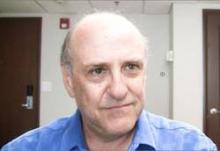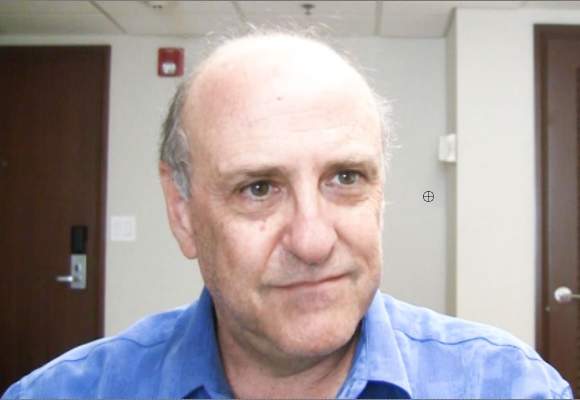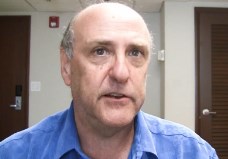User login
Rheumatology Winter Clinical Symposium 2015
Microbiome research is decades away from benefiting human health
MAUI, HAWAII – Don’t look for findings about the human microbiome to have any imminent impact on health, said rheumatologist Peter Lipsky.
The human microbiome “is the most exciting area in science at the moment, but also the most hyped. There’s a tendency in this field driven both by scientists and the NIH [National Institutes of Health], as well as by commercial interests, to explain every [condition as it relates to] the microbiome,” he said at the 2015 Rheumatology Winter Clinical Symposium.
Most of our understanding about the microbiome comes from “very reductionist experiments” in genetically altered mice, often raised in germ-free environments “where you can control everything.” The findings have no clear use in human medicine, and have not led to any breakthroughs. To date, there have been only a few microbiome studies in people, and they’ve been solely descriptive, said Dr. Lipsky, former chief of the autoimmunity branch at the National Institute of Arthritis and Musculoskeletal and Skin Diseases.
Microbiome research examines how normal human bacteria might have something to do with illness. The field has much in common with human genome mapping in the mid-1990s; it is in the data-gathering phase with little evidence of benefit.
It will take decades to fully figure out how vast and ever-changing communities of bacteria interact with each other and the human body, and how to selectively manipulate them to improve human health. Humans carry about 3 pounds of bacteria on and in their bodies, with bacterial cells outnumbering human cells by about 10:1. Those 3 pounds are composed of thousands of bacterial species, and new species are being discovered almost daily, thanks to advances in molecular technology.
“It’s impossible with the technology that we have now to integrate the actions of all these organisms,” said Dr. Lipsky of Charlottesville, Va.
Even so, the Internet is awash in ads for prebiotics, probiotics, and other products to balance the human microbiome. There are companies that take stool samples to diagnose and correct microbiome imbalances.
“Does this make any sense today? No,” Dr. Lipsky said. “You are never going to be able to stop patients from taking risks, but there is a certain amount of caution that needs to be exerted here. What you can tell patients is that this is an exciting area, but it’s in its early stage. There is really no scientific basis for any of these products. Most of them probably don’t do any harm, but I don’t know that for certain. The same organism that might protect against colon cancer could facilitate rheumatoid arthritis or periodontal disease,” he said.
Dr. Lipsky supported his thesis with a review of the latest human findings. One study found an aberration in oral microbiota in new-onset rheumatoid arthritis (RA). A stool sample study correlated an overabundance of gut Prevotella copri with RA. Another found changes in gut bacteria in psoriasis and psoriatic arthritis that seem similar to those seen in inflammatory bowel disease. It’s unknown if the disease caused the imbalance or visa versa.
Another small study found a drop in gut Firmicutes families in lupus (mBio 2014;5:e01548-14). “How and why this microbial community influences [lupus] remains to be elucidated,” the authors noted.
Dr. Lipsky is an adviser for Janssen and a consultant for Pfizer.
MAUI, HAWAII – Don’t look for findings about the human microbiome to have any imminent impact on health, said rheumatologist Peter Lipsky.
The human microbiome “is the most exciting area in science at the moment, but also the most hyped. There’s a tendency in this field driven both by scientists and the NIH [National Institutes of Health], as well as by commercial interests, to explain every [condition as it relates to] the microbiome,” he said at the 2015 Rheumatology Winter Clinical Symposium.
Most of our understanding about the microbiome comes from “very reductionist experiments” in genetically altered mice, often raised in germ-free environments “where you can control everything.” The findings have no clear use in human medicine, and have not led to any breakthroughs. To date, there have been only a few microbiome studies in people, and they’ve been solely descriptive, said Dr. Lipsky, former chief of the autoimmunity branch at the National Institute of Arthritis and Musculoskeletal and Skin Diseases.
Microbiome research examines how normal human bacteria might have something to do with illness. The field has much in common with human genome mapping in the mid-1990s; it is in the data-gathering phase with little evidence of benefit.
It will take decades to fully figure out how vast and ever-changing communities of bacteria interact with each other and the human body, and how to selectively manipulate them to improve human health. Humans carry about 3 pounds of bacteria on and in their bodies, with bacterial cells outnumbering human cells by about 10:1. Those 3 pounds are composed of thousands of bacterial species, and new species are being discovered almost daily, thanks to advances in molecular technology.
“It’s impossible with the technology that we have now to integrate the actions of all these organisms,” said Dr. Lipsky of Charlottesville, Va.
Even so, the Internet is awash in ads for prebiotics, probiotics, and other products to balance the human microbiome. There are companies that take stool samples to diagnose and correct microbiome imbalances.
“Does this make any sense today? No,” Dr. Lipsky said. “You are never going to be able to stop patients from taking risks, but there is a certain amount of caution that needs to be exerted here. What you can tell patients is that this is an exciting area, but it’s in its early stage. There is really no scientific basis for any of these products. Most of them probably don’t do any harm, but I don’t know that for certain. The same organism that might protect against colon cancer could facilitate rheumatoid arthritis or periodontal disease,” he said.
Dr. Lipsky supported his thesis with a review of the latest human findings. One study found an aberration in oral microbiota in new-onset rheumatoid arthritis (RA). A stool sample study correlated an overabundance of gut Prevotella copri with RA. Another found changes in gut bacteria in psoriasis and psoriatic arthritis that seem similar to those seen in inflammatory bowel disease. It’s unknown if the disease caused the imbalance or visa versa.
Another small study found a drop in gut Firmicutes families in lupus (mBio 2014;5:e01548-14). “How and why this microbial community influences [lupus] remains to be elucidated,” the authors noted.
Dr. Lipsky is an adviser for Janssen and a consultant for Pfizer.
MAUI, HAWAII – Don’t look for findings about the human microbiome to have any imminent impact on health, said rheumatologist Peter Lipsky.
The human microbiome “is the most exciting area in science at the moment, but also the most hyped. There’s a tendency in this field driven both by scientists and the NIH [National Institutes of Health], as well as by commercial interests, to explain every [condition as it relates to] the microbiome,” he said at the 2015 Rheumatology Winter Clinical Symposium.
Most of our understanding about the microbiome comes from “very reductionist experiments” in genetically altered mice, often raised in germ-free environments “where you can control everything.” The findings have no clear use in human medicine, and have not led to any breakthroughs. To date, there have been only a few microbiome studies in people, and they’ve been solely descriptive, said Dr. Lipsky, former chief of the autoimmunity branch at the National Institute of Arthritis and Musculoskeletal and Skin Diseases.
Microbiome research examines how normal human bacteria might have something to do with illness. The field has much in common with human genome mapping in the mid-1990s; it is in the data-gathering phase with little evidence of benefit.
It will take decades to fully figure out how vast and ever-changing communities of bacteria interact with each other and the human body, and how to selectively manipulate them to improve human health. Humans carry about 3 pounds of bacteria on and in their bodies, with bacterial cells outnumbering human cells by about 10:1. Those 3 pounds are composed of thousands of bacterial species, and new species are being discovered almost daily, thanks to advances in molecular technology.
“It’s impossible with the technology that we have now to integrate the actions of all these organisms,” said Dr. Lipsky of Charlottesville, Va.
Even so, the Internet is awash in ads for prebiotics, probiotics, and other products to balance the human microbiome. There are companies that take stool samples to diagnose and correct microbiome imbalances.
“Does this make any sense today? No,” Dr. Lipsky said. “You are never going to be able to stop patients from taking risks, but there is a certain amount of caution that needs to be exerted here. What you can tell patients is that this is an exciting area, but it’s in its early stage. There is really no scientific basis for any of these products. Most of them probably don’t do any harm, but I don’t know that for certain. The same organism that might protect against colon cancer could facilitate rheumatoid arthritis or periodontal disease,” he said.
Dr. Lipsky supported his thesis with a review of the latest human findings. One study found an aberration in oral microbiota in new-onset rheumatoid arthritis (RA). A stool sample study correlated an overabundance of gut Prevotella copri with RA. Another found changes in gut bacteria in psoriasis and psoriatic arthritis that seem similar to those seen in inflammatory bowel disease. It’s unknown if the disease caused the imbalance or visa versa.
Another small study found a drop in gut Firmicutes families in lupus (mBio 2014;5:e01548-14). “How and why this microbial community influences [lupus] remains to be elucidated,” the authors noted.
Dr. Lipsky is an adviser for Janssen and a consultant for Pfizer.
EXPERT ANALYSIS FROM RWCS 2015
Vasculitis patients need up-front protection from steroid side effects
MAUI, HAWAII – When vasculitis patients are started on corticosteroids, they should also be started on treatments to protect them from the adverse effects of steroids, said Dr. Alvin Wells, director of the Rheumatology and Immunotherapy Center in Franklin, Wis.
“You give a decent dose of corticosteroids” for giant cell arteritis (GCA), and generally smaller but still significant doses for polymyalgia rheumatica (PMR). In either case, “many of these patients will be on [steroids] for a long time. Indeed, many people will be on them lifelong, so you really have to think about protection up front,” Dr. Wells said at the 2015 Rheumatology Winter Clinical Symposium.
That means bisphosphonates or some other agent to protect against steroid-induced bone loss, and proton-pump inhibitors to protect against gastric ulcers that can occur with high-dose prednisone. If not contraindicated, baby aspirin to protect against a potentially heightened risk of ischemic cardiovascular events should be considered in GCA patients.
Unfortunately, “it’s hard to take [vasculitis patients] off their steroids,” and there’s no single go-to therapy to prevent vasculitis flares when steroids are tapered, Dr. Wells said. “We’ve all tried everything that comes up on the short list,” such as methotrexate, azathioprine, dapsone, tocilizumab, and others. Methotrexate has only been shown to be of marginal benefit, and there’s only anecdotal support for other options. Many flare treatments “really aren’t steroid sparing” and probably offer little or no benefit.
In PMR, the possibility of cancer has to be kept in mind, as well. Although uncommon, PMR can be the first sign of malignancy, so “these patients need to be screened aggressively regardless of their age and what [treatment] guidelines say,” he said.
Recently, interleukin-10 (IL-10), an anti-inflammatory cytokine, has been shown to be down regulated in antineutrophil cytoplasmic antibody (ANCA)–associated vasculitis, and especially in patients with active disease. People with the condition have lower numbers of IL-10–producing B cells than healthy controls have.
“IL-10 seems to be playing a role. The caveat is that this is not ready for primetime.” There are issues with how best to define levels and measure IL-10, and at what time of day. Even so, “I think the future will be in measuring [cytokines to] predict who’s going to have a flare and who needs more aggressive therapy. I think this [new finding] is a piece of data that might help us out,” Dr. Wells said.
Here’s another issue “that comes up all the time” with systemic vasculitis: “Do we still need cyclophosphamide,” with all its side effects? The risk-benefit discussion can be tough, especially when you have to tell young people, “I’m going to give you cyclophosphamide and, by the way, you’re not going to be able to have kids,” Dr. Wells said.
Over the past few years, induction and maintenance with other agents – such as rituximab – have been shown “to be pretty decent.” Dr. Wells said he seldom needs to have those conversations these days; “I can reserve cyclophosphamide for the really, really sick patients.”
Dr. Wells is on the speakers bureaus of AbbVie, Amgen, Bristol-Myers Squibb, and Pfizer.
MAUI, HAWAII – When vasculitis patients are started on corticosteroids, they should also be started on treatments to protect them from the adverse effects of steroids, said Dr. Alvin Wells, director of the Rheumatology and Immunotherapy Center in Franklin, Wis.
“You give a decent dose of corticosteroids” for giant cell arteritis (GCA), and generally smaller but still significant doses for polymyalgia rheumatica (PMR). In either case, “many of these patients will be on [steroids] for a long time. Indeed, many people will be on them lifelong, so you really have to think about protection up front,” Dr. Wells said at the 2015 Rheumatology Winter Clinical Symposium.
That means bisphosphonates or some other agent to protect against steroid-induced bone loss, and proton-pump inhibitors to protect against gastric ulcers that can occur with high-dose prednisone. If not contraindicated, baby aspirin to protect against a potentially heightened risk of ischemic cardiovascular events should be considered in GCA patients.
Unfortunately, “it’s hard to take [vasculitis patients] off their steroids,” and there’s no single go-to therapy to prevent vasculitis flares when steroids are tapered, Dr. Wells said. “We’ve all tried everything that comes up on the short list,” such as methotrexate, azathioprine, dapsone, tocilizumab, and others. Methotrexate has only been shown to be of marginal benefit, and there’s only anecdotal support for other options. Many flare treatments “really aren’t steroid sparing” and probably offer little or no benefit.
In PMR, the possibility of cancer has to be kept in mind, as well. Although uncommon, PMR can be the first sign of malignancy, so “these patients need to be screened aggressively regardless of their age and what [treatment] guidelines say,” he said.
Recently, interleukin-10 (IL-10), an anti-inflammatory cytokine, has been shown to be down regulated in antineutrophil cytoplasmic antibody (ANCA)–associated vasculitis, and especially in patients with active disease. People with the condition have lower numbers of IL-10–producing B cells than healthy controls have.
“IL-10 seems to be playing a role. The caveat is that this is not ready for primetime.” There are issues with how best to define levels and measure IL-10, and at what time of day. Even so, “I think the future will be in measuring [cytokines to] predict who’s going to have a flare and who needs more aggressive therapy. I think this [new finding] is a piece of data that might help us out,” Dr. Wells said.
Here’s another issue “that comes up all the time” with systemic vasculitis: “Do we still need cyclophosphamide,” with all its side effects? The risk-benefit discussion can be tough, especially when you have to tell young people, “I’m going to give you cyclophosphamide and, by the way, you’re not going to be able to have kids,” Dr. Wells said.
Over the past few years, induction and maintenance with other agents – such as rituximab – have been shown “to be pretty decent.” Dr. Wells said he seldom needs to have those conversations these days; “I can reserve cyclophosphamide for the really, really sick patients.”
Dr. Wells is on the speakers bureaus of AbbVie, Amgen, Bristol-Myers Squibb, and Pfizer.
MAUI, HAWAII – When vasculitis patients are started on corticosteroids, they should also be started on treatments to protect them from the adverse effects of steroids, said Dr. Alvin Wells, director of the Rheumatology and Immunotherapy Center in Franklin, Wis.
“You give a decent dose of corticosteroids” for giant cell arteritis (GCA), and generally smaller but still significant doses for polymyalgia rheumatica (PMR). In either case, “many of these patients will be on [steroids] for a long time. Indeed, many people will be on them lifelong, so you really have to think about protection up front,” Dr. Wells said at the 2015 Rheumatology Winter Clinical Symposium.
That means bisphosphonates or some other agent to protect against steroid-induced bone loss, and proton-pump inhibitors to protect against gastric ulcers that can occur with high-dose prednisone. If not contraindicated, baby aspirin to protect against a potentially heightened risk of ischemic cardiovascular events should be considered in GCA patients.
Unfortunately, “it’s hard to take [vasculitis patients] off their steroids,” and there’s no single go-to therapy to prevent vasculitis flares when steroids are tapered, Dr. Wells said. “We’ve all tried everything that comes up on the short list,” such as methotrexate, azathioprine, dapsone, tocilizumab, and others. Methotrexate has only been shown to be of marginal benefit, and there’s only anecdotal support for other options. Many flare treatments “really aren’t steroid sparing” and probably offer little or no benefit.
In PMR, the possibility of cancer has to be kept in mind, as well. Although uncommon, PMR can be the first sign of malignancy, so “these patients need to be screened aggressively regardless of their age and what [treatment] guidelines say,” he said.
Recently, interleukin-10 (IL-10), an anti-inflammatory cytokine, has been shown to be down regulated in antineutrophil cytoplasmic antibody (ANCA)–associated vasculitis, and especially in patients with active disease. People with the condition have lower numbers of IL-10–producing B cells than healthy controls have.
“IL-10 seems to be playing a role. The caveat is that this is not ready for primetime.” There are issues with how best to define levels and measure IL-10, and at what time of day. Even so, “I think the future will be in measuring [cytokines to] predict who’s going to have a flare and who needs more aggressive therapy. I think this [new finding] is a piece of data that might help us out,” Dr. Wells said.
Here’s another issue “that comes up all the time” with systemic vasculitis: “Do we still need cyclophosphamide,” with all its side effects? The risk-benefit discussion can be tough, especially when you have to tell young people, “I’m going to give you cyclophosphamide and, by the way, you’re not going to be able to have kids,” Dr. Wells said.
Over the past few years, induction and maintenance with other agents – such as rituximab – have been shown “to be pretty decent.” Dr. Wells said he seldom needs to have those conversations these days; “I can reserve cyclophosphamide for the really, really sick patients.”
Dr. Wells is on the speakers bureaus of AbbVie, Amgen, Bristol-Myers Squibb, and Pfizer.
EXPERT ANALYSIS AT RWCS 2015
Gout management best practices require getting around misconceptions
MAUI, HAWAII – Urate-lowering therapy doesn’t have to be suspended while gout patients are treated for acute attacks, according to rheumatologist Orrin Troum of Santa Monica, Calif.
In fact, there are arguments against it; stopping allopurinol or other urate-lowering therapies (ULTs) during an attack doesn’t seem to help, and there’s a chance that patients might have another attack when it’s reintroduced. Still, the practice persists despite evidence and recommendations to the contrary, Dr. Troum said at the 2015 Rheumatology Winter Clinical Symposium.
Gout is a curable or at least eminently manageable condition, but it remains a tricky problem to treat. Part of that is because referring physicians might be using an out-of-date playbook before sending patients for a rheumatology consult; another issue is that optimal care requires follow-up visits, which might not always be possible.
Gout management guidelines from the European League Against Rheumatism (Ann. Rheum. Dis. 2006;65:1312-24) and the American College of Rheumatology (Arthritis Care Res. 2012;64:1431-46) now largely concur on how best to handle the condition, which might help bring uniformity to gout management if their message filters through to other branches of medicine, said rheumatologist and copresenter Martin Bergman of the department of rheumatology at Drexel University in Philadelphia.
Another persistent misconception is that ULT can’t be started during an acute attack. “There are some very good studies showing” that it can so long as antiflare drugs are on board and patients follow up to check for hypersensitivity reactions and other potential ULT problems, said Dr. Bergman, also chief of rheumatology at Taylor Hospital in Ridley Park, Pa.
Starting low and going slow, a key concept with ULT, hasn’t fully taken hold outside the rheumatology community, either. With allopurinol, that means starting at 100 mg/day – and 50 mg/day in those with chronic kidney disease – then titrating up slowly over several follow-up visits to an effective serum uric acid (SUA)–lowering dose. The idea is to lower serum uric acid slowly, to avoid precipitating an acute attack.
Even so, patients are still sometimes started on 300 mg/day, and although more than half will need more than 300 mg/day to reach SUA targets, that dose is still sometimes considered to be the maximum allowable.
Overall, the consensus on both sides of the Atlantic is that gout patients need to have serum urate levels below 6 mg/dL, and below 5 mg/dL if they have tophi.
“So the next question is, ‘How low do you go?’ ” It’s recently been found that “lifelong maintenance on very low levels of uric acid might actually increase the risk of neurodegenerative diseases, such as Parkinson’s, multiple sclerosis, and dementia.” Uric acid is a strong antioxidant that, perhaps, has protective effects in the central nervous system, Dr. Troum said.
It might be best to go below 5 mg/dL in severe gout for only 3-5 years, then loosen the target to 5-6 mg/dL (Nat. Rev. Rheumatol. 2014;10:271-83), he added.
Among other recent developments, it’s now known that psoriasis and psoriatic arthritis substantially increase the risk of gout (Ann. Rheum. Dis. 2014 March 20 [doi:10.1136/annrheumdis-2014-205212]), so it’s important to check for gout crystals when aspirating inflamed joints in those conditions. It remains unclear, however, if psoriasis or gout should take precedence when crystals are found, Dr. Bergman said.
Also, it makes sense to screen patients for their HLA-B genotype. Carriers of the variant allele HLA-B*5801 are at high risk for severe cutaneous adverse reactions with allopurinol, so another ULT is probably a better option. The variant is most common in individuals of Korean, Han Chinese, or Thai descent (Clin. Pharmacol. Ther. 2013;93:153-8).
Dr. Troum is an adviser, consultant, speaker, or grant recipient for several companies, including AbbVie, Amgen, Bristol-Myers Squibb, Centocor, Novartis, Pfizer, and Roche. He holds shares in Theralogix. Dr. Bergman is an adviser, speaker, or consultant for several companies, as well, including AbbVie, Celgene, Amgen, and Roche. He holds shares in Bristol-Myers Squibb, Pfizer, and Johnson & Johnson.
MAUI, HAWAII – Urate-lowering therapy doesn’t have to be suspended while gout patients are treated for acute attacks, according to rheumatologist Orrin Troum of Santa Monica, Calif.
In fact, there are arguments against it; stopping allopurinol or other urate-lowering therapies (ULTs) during an attack doesn’t seem to help, and there’s a chance that patients might have another attack when it’s reintroduced. Still, the practice persists despite evidence and recommendations to the contrary, Dr. Troum said at the 2015 Rheumatology Winter Clinical Symposium.
Gout is a curable or at least eminently manageable condition, but it remains a tricky problem to treat. Part of that is because referring physicians might be using an out-of-date playbook before sending patients for a rheumatology consult; another issue is that optimal care requires follow-up visits, which might not always be possible.
Gout management guidelines from the European League Against Rheumatism (Ann. Rheum. Dis. 2006;65:1312-24) and the American College of Rheumatology (Arthritis Care Res. 2012;64:1431-46) now largely concur on how best to handle the condition, which might help bring uniformity to gout management if their message filters through to other branches of medicine, said rheumatologist and copresenter Martin Bergman of the department of rheumatology at Drexel University in Philadelphia.
Another persistent misconception is that ULT can’t be started during an acute attack. “There are some very good studies showing” that it can so long as antiflare drugs are on board and patients follow up to check for hypersensitivity reactions and other potential ULT problems, said Dr. Bergman, also chief of rheumatology at Taylor Hospital in Ridley Park, Pa.
Starting low and going slow, a key concept with ULT, hasn’t fully taken hold outside the rheumatology community, either. With allopurinol, that means starting at 100 mg/day – and 50 mg/day in those with chronic kidney disease – then titrating up slowly over several follow-up visits to an effective serum uric acid (SUA)–lowering dose. The idea is to lower serum uric acid slowly, to avoid precipitating an acute attack.
Even so, patients are still sometimes started on 300 mg/day, and although more than half will need more than 300 mg/day to reach SUA targets, that dose is still sometimes considered to be the maximum allowable.
Overall, the consensus on both sides of the Atlantic is that gout patients need to have serum urate levels below 6 mg/dL, and below 5 mg/dL if they have tophi.
“So the next question is, ‘How low do you go?’ ” It’s recently been found that “lifelong maintenance on very low levels of uric acid might actually increase the risk of neurodegenerative diseases, such as Parkinson’s, multiple sclerosis, and dementia.” Uric acid is a strong antioxidant that, perhaps, has protective effects in the central nervous system, Dr. Troum said.
It might be best to go below 5 mg/dL in severe gout for only 3-5 years, then loosen the target to 5-6 mg/dL (Nat. Rev. Rheumatol. 2014;10:271-83), he added.
Among other recent developments, it’s now known that psoriasis and psoriatic arthritis substantially increase the risk of gout (Ann. Rheum. Dis. 2014 March 20 [doi:10.1136/annrheumdis-2014-205212]), so it’s important to check for gout crystals when aspirating inflamed joints in those conditions. It remains unclear, however, if psoriasis or gout should take precedence when crystals are found, Dr. Bergman said.
Also, it makes sense to screen patients for their HLA-B genotype. Carriers of the variant allele HLA-B*5801 are at high risk for severe cutaneous adverse reactions with allopurinol, so another ULT is probably a better option. The variant is most common in individuals of Korean, Han Chinese, or Thai descent (Clin. Pharmacol. Ther. 2013;93:153-8).
Dr. Troum is an adviser, consultant, speaker, or grant recipient for several companies, including AbbVie, Amgen, Bristol-Myers Squibb, Centocor, Novartis, Pfizer, and Roche. He holds shares in Theralogix. Dr. Bergman is an adviser, speaker, or consultant for several companies, as well, including AbbVie, Celgene, Amgen, and Roche. He holds shares in Bristol-Myers Squibb, Pfizer, and Johnson & Johnson.
MAUI, HAWAII – Urate-lowering therapy doesn’t have to be suspended while gout patients are treated for acute attacks, according to rheumatologist Orrin Troum of Santa Monica, Calif.
In fact, there are arguments against it; stopping allopurinol or other urate-lowering therapies (ULTs) during an attack doesn’t seem to help, and there’s a chance that patients might have another attack when it’s reintroduced. Still, the practice persists despite evidence and recommendations to the contrary, Dr. Troum said at the 2015 Rheumatology Winter Clinical Symposium.
Gout is a curable or at least eminently manageable condition, but it remains a tricky problem to treat. Part of that is because referring physicians might be using an out-of-date playbook before sending patients for a rheumatology consult; another issue is that optimal care requires follow-up visits, which might not always be possible.
Gout management guidelines from the European League Against Rheumatism (Ann. Rheum. Dis. 2006;65:1312-24) and the American College of Rheumatology (Arthritis Care Res. 2012;64:1431-46) now largely concur on how best to handle the condition, which might help bring uniformity to gout management if their message filters through to other branches of medicine, said rheumatologist and copresenter Martin Bergman of the department of rheumatology at Drexel University in Philadelphia.
Another persistent misconception is that ULT can’t be started during an acute attack. “There are some very good studies showing” that it can so long as antiflare drugs are on board and patients follow up to check for hypersensitivity reactions and other potential ULT problems, said Dr. Bergman, also chief of rheumatology at Taylor Hospital in Ridley Park, Pa.
Starting low and going slow, a key concept with ULT, hasn’t fully taken hold outside the rheumatology community, either. With allopurinol, that means starting at 100 mg/day – and 50 mg/day in those with chronic kidney disease – then titrating up slowly over several follow-up visits to an effective serum uric acid (SUA)–lowering dose. The idea is to lower serum uric acid slowly, to avoid precipitating an acute attack.
Even so, patients are still sometimes started on 300 mg/day, and although more than half will need more than 300 mg/day to reach SUA targets, that dose is still sometimes considered to be the maximum allowable.
Overall, the consensus on both sides of the Atlantic is that gout patients need to have serum urate levels below 6 mg/dL, and below 5 mg/dL if they have tophi.
“So the next question is, ‘How low do you go?’ ” It’s recently been found that “lifelong maintenance on very low levels of uric acid might actually increase the risk of neurodegenerative diseases, such as Parkinson’s, multiple sclerosis, and dementia.” Uric acid is a strong antioxidant that, perhaps, has protective effects in the central nervous system, Dr. Troum said.
It might be best to go below 5 mg/dL in severe gout for only 3-5 years, then loosen the target to 5-6 mg/dL (Nat. Rev. Rheumatol. 2014;10:271-83), he added.
Among other recent developments, it’s now known that psoriasis and psoriatic arthritis substantially increase the risk of gout (Ann. Rheum. Dis. 2014 March 20 [doi:10.1136/annrheumdis-2014-205212]), so it’s important to check for gout crystals when aspirating inflamed joints in those conditions. It remains unclear, however, if psoriasis or gout should take precedence when crystals are found, Dr. Bergman said.
Also, it makes sense to screen patients for their HLA-B genotype. Carriers of the variant allele HLA-B*5801 are at high risk for severe cutaneous adverse reactions with allopurinol, so another ULT is probably a better option. The variant is most common in individuals of Korean, Han Chinese, or Thai descent (Clin. Pharmacol. Ther. 2013;93:153-8).
Dr. Troum is an adviser, consultant, speaker, or grant recipient for several companies, including AbbVie, Amgen, Bristol-Myers Squibb, Centocor, Novartis, Pfizer, and Roche. He holds shares in Theralogix. Dr. Bergman is an adviser, speaker, or consultant for several companies, as well, including AbbVie, Celgene, Amgen, and Roche. He holds shares in Bristol-Myers Squibb, Pfizer, and Johnson & Johnson.
EXPERT ANALYSIS AT RWCS 2015
VIDEO: SLE diagnosis takes more than high ANA levels
MAUI, Hawaii – Do not diagnose systemic lupus erythematosus based on vague clinical symptoms and an elevated antinuclear antibody blood test.
As incredible as it seems, Dr. Alvin Wells, director of the Rheumatology and Immunotherapy Center in Franklin, Wis., said he sees doctors doing that all the time in his practice.
SLE is a serious and tricky diagnosis that has long-standing consequences for patients, he said.
Even road rage before an appointment can throw off blood tests. Also, SLE doesn’t seem to be one disease, so drugs have to be picked based on manifestations. Belimumab is a good example of that. Dr. Wells explained those and other insights at the Rheumatology Winter Clinical Symposium.
The video associated with this article is no longer available on this site. Please view all of our videos on the MDedge YouTube channel
MAUI, Hawaii – Do not diagnose systemic lupus erythematosus based on vague clinical symptoms and an elevated antinuclear antibody blood test.
As incredible as it seems, Dr. Alvin Wells, director of the Rheumatology and Immunotherapy Center in Franklin, Wis., said he sees doctors doing that all the time in his practice.
SLE is a serious and tricky diagnosis that has long-standing consequences for patients, he said.
Even road rage before an appointment can throw off blood tests. Also, SLE doesn’t seem to be one disease, so drugs have to be picked based on manifestations. Belimumab is a good example of that. Dr. Wells explained those and other insights at the Rheumatology Winter Clinical Symposium.
The video associated with this article is no longer available on this site. Please view all of our videos on the MDedge YouTube channel
MAUI, Hawaii – Do not diagnose systemic lupus erythematosus based on vague clinical symptoms and an elevated antinuclear antibody blood test.
As incredible as it seems, Dr. Alvin Wells, director of the Rheumatology and Immunotherapy Center in Franklin, Wis., said he sees doctors doing that all the time in his practice.
SLE is a serious and tricky diagnosis that has long-standing consequences for patients, he said.
Even road rage before an appointment can throw off blood tests. Also, SLE doesn’t seem to be one disease, so drugs have to be picked based on manifestations. Belimumab is a good example of that. Dr. Wells explained those and other insights at the Rheumatology Winter Clinical Symposium.
The video associated with this article is no longer available on this site. Please view all of our videos on the MDedge YouTube channel
AT RWCS 2015
VIDEO: True remission necessary before tapering or discontinuing RA drugs
MAUI, HAWAII– Discontinuing medications when rheumatoid arthritis patients are doing well is a hot topic in rheumatology lately, but it’s tricky.
The idea is to give patients a break from the costs and side effects of steroids, methotrexate, and biologics. Whether or not doing so is a good idea has a lot to do with how you define remission, and the odds of recapturing patients if they flare.
Advice from Dr. Roy Fleischmann, a clinical professor of rheumatology at the University of Texas Southwestern Medical Center in Dallas, might help. At the 2015 Rheumatology Winter Clinical Symposium, he shared his know-how about tapering and discontinuing treatments, culled from his professional experience and the literature on the subject in a video interview.
The video associated with this article is no longer available on this site. Please view all of our videos on the MDedge YouTube channel
MAUI, HAWAII– Discontinuing medications when rheumatoid arthritis patients are doing well is a hot topic in rheumatology lately, but it’s tricky.
The idea is to give patients a break from the costs and side effects of steroids, methotrexate, and biologics. Whether or not doing so is a good idea has a lot to do with how you define remission, and the odds of recapturing patients if they flare.
Advice from Dr. Roy Fleischmann, a clinical professor of rheumatology at the University of Texas Southwestern Medical Center in Dallas, might help. At the 2015 Rheumatology Winter Clinical Symposium, he shared his know-how about tapering and discontinuing treatments, culled from his professional experience and the literature on the subject in a video interview.
The video associated with this article is no longer available on this site. Please view all of our videos on the MDedge YouTube channel
MAUI, HAWAII– Discontinuing medications when rheumatoid arthritis patients are doing well is a hot topic in rheumatology lately, but it’s tricky.
The idea is to give patients a break from the costs and side effects of steroids, methotrexate, and biologics. Whether or not doing so is a good idea has a lot to do with how you define remission, and the odds of recapturing patients if they flare.
Advice from Dr. Roy Fleischmann, a clinical professor of rheumatology at the University of Texas Southwestern Medical Center in Dallas, might help. At the 2015 Rheumatology Winter Clinical Symposium, he shared his know-how about tapering and discontinuing treatments, culled from his professional experience and the literature on the subject in a video interview.
The video associated with this article is no longer available on this site. Please view all of our videos on the MDedge YouTube channel
AT RWCS 2015
VIDEO: Homeopathic injectables topped placebo for knee osteoarthritis
MAUI, HAWAII – Two homeopathic injectables, as well as the familiar combination of glucosamine and chondroitin, showed promise in two studies of alternative treatments for osteoarthritis.
In an interview at the 2015 Rheumatology Winter Clinical Symposium, Dr. Martin J. Bergman, of the department of rheumatology at Drexel University in Philadelphia, shared the recent results from the two investigations.
The first pitted intra-articular injections of two homeopathic products, Traumeel and Zeel, against placebo saline injections for knee osteoarthritis; the work was sponsored by the products’ German maker, Biologische Heilmittel Heel.
In the second trial, glucosamine and chondroitin sulfate went head to head against celecoxib (Celebrex), also for knee OA. The work was sponsored by Bioibérica, a Spanish company that makes chondroitin and glucosamine, and the investigators reported financial ties to the company.
Traumeel and Zeel may sound exotic, but they aren’t unknown in the rheumatology world – some U.S. rheumatologists are using them, Dr. Bergman, also chief of rheumatology at Taylor Hospital in Ridley Park, Pa., said.
Dr. Bergman disclosed that he has served as an advisor, speaker, or consultant for AbbVie, Amgen, Celgene, and Roche, and holds shares in Bristol-Myers Squibb, Johnson & Johnson, and Pfizer.
The video associated with this article is no longer available on this site. Please view all of our videos on the MDedge YouTube channel
MAUI, HAWAII – Two homeopathic injectables, as well as the familiar combination of glucosamine and chondroitin, showed promise in two studies of alternative treatments for osteoarthritis.
In an interview at the 2015 Rheumatology Winter Clinical Symposium, Dr. Martin J. Bergman, of the department of rheumatology at Drexel University in Philadelphia, shared the recent results from the two investigations.
The first pitted intra-articular injections of two homeopathic products, Traumeel and Zeel, against placebo saline injections for knee osteoarthritis; the work was sponsored by the products’ German maker, Biologische Heilmittel Heel.
In the second trial, glucosamine and chondroitin sulfate went head to head against celecoxib (Celebrex), also for knee OA. The work was sponsored by Bioibérica, a Spanish company that makes chondroitin and glucosamine, and the investigators reported financial ties to the company.
Traumeel and Zeel may sound exotic, but they aren’t unknown in the rheumatology world – some U.S. rheumatologists are using them, Dr. Bergman, also chief of rheumatology at Taylor Hospital in Ridley Park, Pa., said.
Dr. Bergman disclosed that he has served as an advisor, speaker, or consultant for AbbVie, Amgen, Celgene, and Roche, and holds shares in Bristol-Myers Squibb, Johnson & Johnson, and Pfizer.
The video associated with this article is no longer available on this site. Please view all of our videos on the MDedge YouTube channel
MAUI, HAWAII – Two homeopathic injectables, as well as the familiar combination of glucosamine and chondroitin, showed promise in two studies of alternative treatments for osteoarthritis.
In an interview at the 2015 Rheumatology Winter Clinical Symposium, Dr. Martin J. Bergman, of the department of rheumatology at Drexel University in Philadelphia, shared the recent results from the two investigations.
The first pitted intra-articular injections of two homeopathic products, Traumeel and Zeel, against placebo saline injections for knee osteoarthritis; the work was sponsored by the products’ German maker, Biologische Heilmittel Heel.
In the second trial, glucosamine and chondroitin sulfate went head to head against celecoxib (Celebrex), also for knee OA. The work was sponsored by Bioibérica, a Spanish company that makes chondroitin and glucosamine, and the investigators reported financial ties to the company.
Traumeel and Zeel may sound exotic, but they aren’t unknown in the rheumatology world – some U.S. rheumatologists are using them, Dr. Bergman, also chief of rheumatology at Taylor Hospital in Ridley Park, Pa., said.
Dr. Bergman disclosed that he has served as an advisor, speaker, or consultant for AbbVie, Amgen, Celgene, and Roche, and holds shares in Bristol-Myers Squibb, Johnson & Johnson, and Pfizer.
The video associated with this article is no longer available on this site. Please view all of our videos on the MDedge YouTube channel
AT RWCS 2015
VIDEO: Ask patients about metal-on-metal hip implants
MAUI, HAWAII – Rheumatologists and other providers need to ask patients if they’ve had metal-on-metal hip implants.
That goes for hip resurfacing – which by definition is metal on metal – as well as actual metal-on-metal hips. Signs of trouble can be as subtle as mental status changes, and they go well beyond the traditional issues with worn-out artificial joints.
During a video interview at the 2015 Rheumatology Winter Clinical Symposium, Dr. Bill Bugbee, an orthopedic surgeon and professor at the University of California, San Diego, explained the problems and the warning signs for which physicians should watch.
The video associated with this article is no longer available on this site. Please view all of our videos on the MDedge YouTube channel
MAUI, HAWAII – Rheumatologists and other providers need to ask patients if they’ve had metal-on-metal hip implants.
That goes for hip resurfacing – which by definition is metal on metal – as well as actual metal-on-metal hips. Signs of trouble can be as subtle as mental status changes, and they go well beyond the traditional issues with worn-out artificial joints.
During a video interview at the 2015 Rheumatology Winter Clinical Symposium, Dr. Bill Bugbee, an orthopedic surgeon and professor at the University of California, San Diego, explained the problems and the warning signs for which physicians should watch.
The video associated with this article is no longer available on this site. Please view all of our videos on the MDedge YouTube channel
MAUI, HAWAII – Rheumatologists and other providers need to ask patients if they’ve had metal-on-metal hip implants.
That goes for hip resurfacing – which by definition is metal on metal – as well as actual metal-on-metal hips. Signs of trouble can be as subtle as mental status changes, and they go well beyond the traditional issues with worn-out artificial joints.
During a video interview at the 2015 Rheumatology Winter Clinical Symposium, Dr. Bill Bugbee, an orthopedic surgeon and professor at the University of California, San Diego, explained the problems and the warning signs for which physicians should watch.
The video associated with this article is no longer available on this site. Please view all of our videos on the MDedge YouTube channel
AT RWCS 2015
VIDEO: As biosimilars arrive in U.S., treatment questions arise
MAUI, HAWAII – There’s been fairly brisk uptake of biosimilar infliximab in Europe, both for new patients and as a possible switch from Remicade.
That biosimilar infliximab, Remsima, was submitted for U.S. approval in 2014, and a Food and Drug Administration advisory panel recently recommended approval of a biosimilar for filgrastim (Neupogen).
The agents are in the vanguard of what is sure to be an expanding market in the United States as biologics come off patent. Additional infliximab replacements are in the works, as well as biosimilars for etanercept, adalimumab, rituximab, and others.
For rheumatologists, that could mean less expensive treatments for patients, but it’s also likely to make treatment more complicated. Given the complexity of the molecules, the differences between biosimilars and familiar brands could be a bit more marked than those between small-molecule generics and their branded counterparts.
In a video interview at the 2015 Rheumatology Winter Clinical Symposium, Dr. Arthur F. Kavanaugh, a rheumatology professor at the University of California, San Diego, outlined the latest developments and shared his thoughts on the rapidly evolving field.
The video associated with this article is no longer available on this site. Please view all of our videos on the MDedge YouTube channel
MAUI, HAWAII – There’s been fairly brisk uptake of biosimilar infliximab in Europe, both for new patients and as a possible switch from Remicade.
That biosimilar infliximab, Remsima, was submitted for U.S. approval in 2014, and a Food and Drug Administration advisory panel recently recommended approval of a biosimilar for filgrastim (Neupogen).
The agents are in the vanguard of what is sure to be an expanding market in the United States as biologics come off patent. Additional infliximab replacements are in the works, as well as biosimilars for etanercept, adalimumab, rituximab, and others.
For rheumatologists, that could mean less expensive treatments for patients, but it’s also likely to make treatment more complicated. Given the complexity of the molecules, the differences between biosimilars and familiar brands could be a bit more marked than those between small-molecule generics and their branded counterparts.
In a video interview at the 2015 Rheumatology Winter Clinical Symposium, Dr. Arthur F. Kavanaugh, a rheumatology professor at the University of California, San Diego, outlined the latest developments and shared his thoughts on the rapidly evolving field.
The video associated with this article is no longer available on this site. Please view all of our videos on the MDedge YouTube channel
MAUI, HAWAII – There’s been fairly brisk uptake of biosimilar infliximab in Europe, both for new patients and as a possible switch from Remicade.
That biosimilar infliximab, Remsima, was submitted for U.S. approval in 2014, and a Food and Drug Administration advisory panel recently recommended approval of a biosimilar for filgrastim (Neupogen).
The agents are in the vanguard of what is sure to be an expanding market in the United States as biologics come off patent. Additional infliximab replacements are in the works, as well as biosimilars for etanercept, adalimumab, rituximab, and others.
For rheumatologists, that could mean less expensive treatments for patients, but it’s also likely to make treatment more complicated. Given the complexity of the molecules, the differences between biosimilars and familiar brands could be a bit more marked than those between small-molecule generics and their branded counterparts.
In a video interview at the 2015 Rheumatology Winter Clinical Symposium, Dr. Arthur F. Kavanaugh, a rheumatology professor at the University of California, San Diego, outlined the latest developments and shared his thoughts on the rapidly evolving field.
The video associated with this article is no longer available on this site. Please view all of our videos on the MDedge YouTube channel
AT RWCS 2015
VIDEO: Biologics Slowly Taming Metastatic Melanoma
MAUI, HAWAII – Though costly, newer biologics increase 1-year survival with metastatic melanoma from perhaps 40% to more than 70%.
Among the latest are nivolumab and pembrolizumab, antibodies against PD-1 (programmed cell death) cell surface receptors that were approved in 2014 for unresectable melanoma no longer responding to other drugs; another anti-PD-1 is in development.
In this video interview at the 2015 Rheumatology Winter Clinical Symposium, Dr. George Martin of the Dermatology and Laser Center of Maui explains the latest developments and shares his excitement about them.
The video associated with this article is no longer available on this site. Please view all of our videos on the MDedge YouTube channel
MAUI, HAWAII – Though costly, newer biologics increase 1-year survival with metastatic melanoma from perhaps 40% to more than 70%.
Among the latest are nivolumab and pembrolizumab, antibodies against PD-1 (programmed cell death) cell surface receptors that were approved in 2014 for unresectable melanoma no longer responding to other drugs; another anti-PD-1 is in development.
In this video interview at the 2015 Rheumatology Winter Clinical Symposium, Dr. George Martin of the Dermatology and Laser Center of Maui explains the latest developments and shares his excitement about them.
The video associated with this article is no longer available on this site. Please view all of our videos on the MDedge YouTube channel
MAUI, HAWAII – Though costly, newer biologics increase 1-year survival with metastatic melanoma from perhaps 40% to more than 70%.
Among the latest are nivolumab and pembrolizumab, antibodies against PD-1 (programmed cell death) cell surface receptors that were approved in 2014 for unresectable melanoma no longer responding to other drugs; another anti-PD-1 is in development.
In this video interview at the 2015 Rheumatology Winter Clinical Symposium, Dr. George Martin of the Dermatology and Laser Center of Maui explains the latest developments and shares his excitement about them.
The video associated with this article is no longer available on this site. Please view all of our videos on the MDedge YouTube channel
AT RWCS 2015
VIDEO: Biologics slowly taming metastatic melanoma
MAUI, HAWAII – Though costly, newer biologics increase 1-year survival with metastatic melanoma from perhaps 40% to more than 70%.
Among the latest are nivolumab and pembrolizumab, antibodies against PD-1 (programmed cell death) cell surface receptors that were approved in 2014 for unresectable melanoma no longer responding to other drugs; another anti-PD-1 is in development.
In this video interview at the 2015 Rheumatology Winter Clinical Symposium, Dr. George Martin of the Dermatology and Laser Center of Maui explains the latest developments and shares his excitement about them.
The video associated with this article is no longer available on this site. Please view all of our videos on the MDedge YouTube channel
MAUI, HAWAII – Though costly, newer biologics increase 1-year survival with metastatic melanoma from perhaps 40% to more than 70%.
Among the latest are nivolumab and pembrolizumab, antibodies against PD-1 (programmed cell death) cell surface receptors that were approved in 2014 for unresectable melanoma no longer responding to other drugs; another anti-PD-1 is in development.
In this video interview at the 2015 Rheumatology Winter Clinical Symposium, Dr. George Martin of the Dermatology and Laser Center of Maui explains the latest developments and shares his excitement about them.
The video associated with this article is no longer available on this site. Please view all of our videos on the MDedge YouTube channel
MAUI, HAWAII – Though costly, newer biologics increase 1-year survival with metastatic melanoma from perhaps 40% to more than 70%.
Among the latest are nivolumab and pembrolizumab, antibodies against PD-1 (programmed cell death) cell surface receptors that were approved in 2014 for unresectable melanoma no longer responding to other drugs; another anti-PD-1 is in development.
In this video interview at the 2015 Rheumatology Winter Clinical Symposium, Dr. George Martin of the Dermatology and Laser Center of Maui explains the latest developments and shares his excitement about them.
The video associated with this article is no longer available on this site. Please view all of our videos on the MDedge YouTube channel
AT RWCS 2015












